Key takeaways:
- Selective mutism is an anxiety disorder that hampers communication in specific social situations, often tied to fear and past experiences of shyness or social anxiety.
- Understanding selective mutism involves recognizing its genetic, environmental, and psychological influences, as well as its impact on children during transitional phases.
- Effective communication strategies include leveraging technology, using visual cues, and creating supportive environments that embrace silence as a means of connection.
- Personal experiences with silence can foster empathy, reflection, and self-advocacy, highlighting the importance of patience in understanding communication challenges.
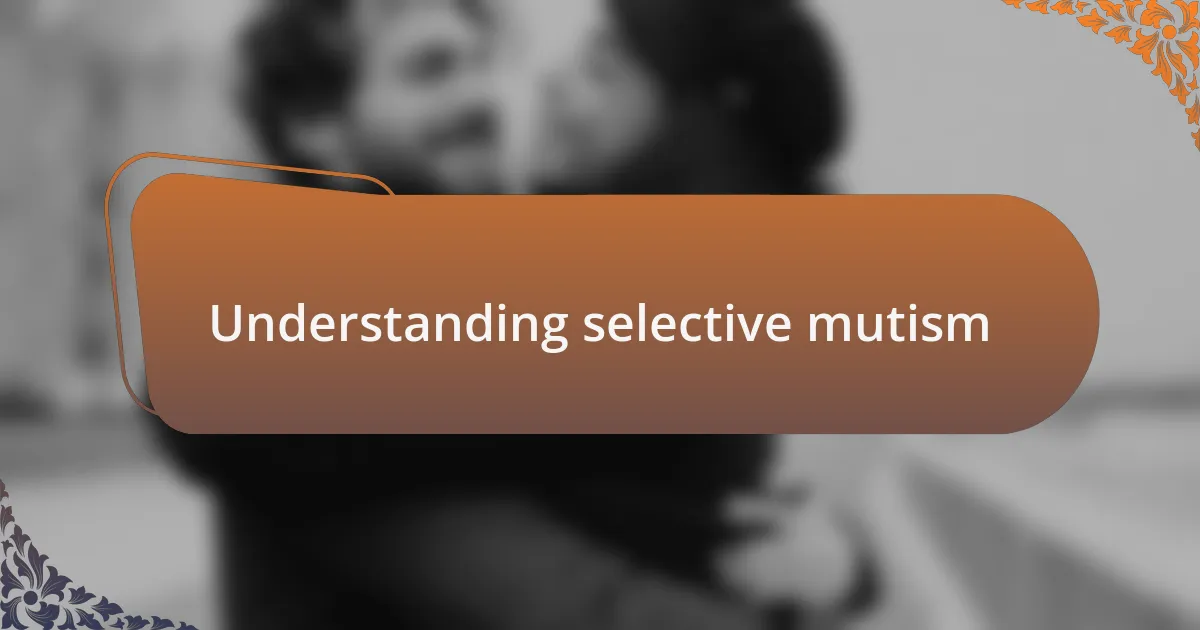
Understanding selective mutism
Selective mutism is more than just a reluctance to speak; it’s a complex anxiety disorder that affects a person’s ability to communicate in certain social settings. I remember feeling an almost suffocating pressure in my chest during family gatherings, where the chatter around me felt overwhelming. Have you ever felt so paralyzed by your surroundings that even a simple hello seemed impossible to express?
Understanding this condition requires empathy, as those affected often want to speak but become trapped in a loop of fear and anxiety. I can vividly recall standing at the edge of a classroom, silently wishing I could find my voice to answer a question, but feeling as though my tongue was glued to the roof of my mouth. This experience isn’t just about a fear of talking; it’s often tied to deep-seated experiences of shyness or social anxiety that can linger over time.
The silence surrounding selective mutism often leads to misconceptions and misunderstandings, further isolating those who struggle with it. When I encountered peers who didn’t understand my silence, their confusion mirrored my own frustration. How can we bridge that gap? By fostering open conversations and patience, we can create a more accepting environment where individuals feel safe to express themselves, one word at a time.

Causes of selective mutism
Selective mutism often stems from a combination of genetic, environmental, and psychological factors. I learned that children who experience anxiety disorders within their families may be more prone to develop this condition, as my own family’s struggles with anxiety created a ripple effect. Have you noticed how family dynamics can shape our behaviors in profound ways?
Social situations play a critical role too. I remember feeling an unshakeable fear during school presentations, which was exacerbated by past experiences of being teased. This fear can create a cycle where the anticipation of anxiety leads to avoidance, making the act of speaking feel increasingly daunting. Have you ever felt stuck in a situation because of the overwhelming pressure of others’ expectations?
Additionally, I found that early childhood experiences significantly influence the development of selective mutism. I encountered a classmate whose quiet demeanor stemmed from being in a new environment without familiar faces. It made me realize that transitions, such as moving or starting school, can trigger these responses in sensitive children. How many times do we overlook the impact of change on a child’s emotional landscape?
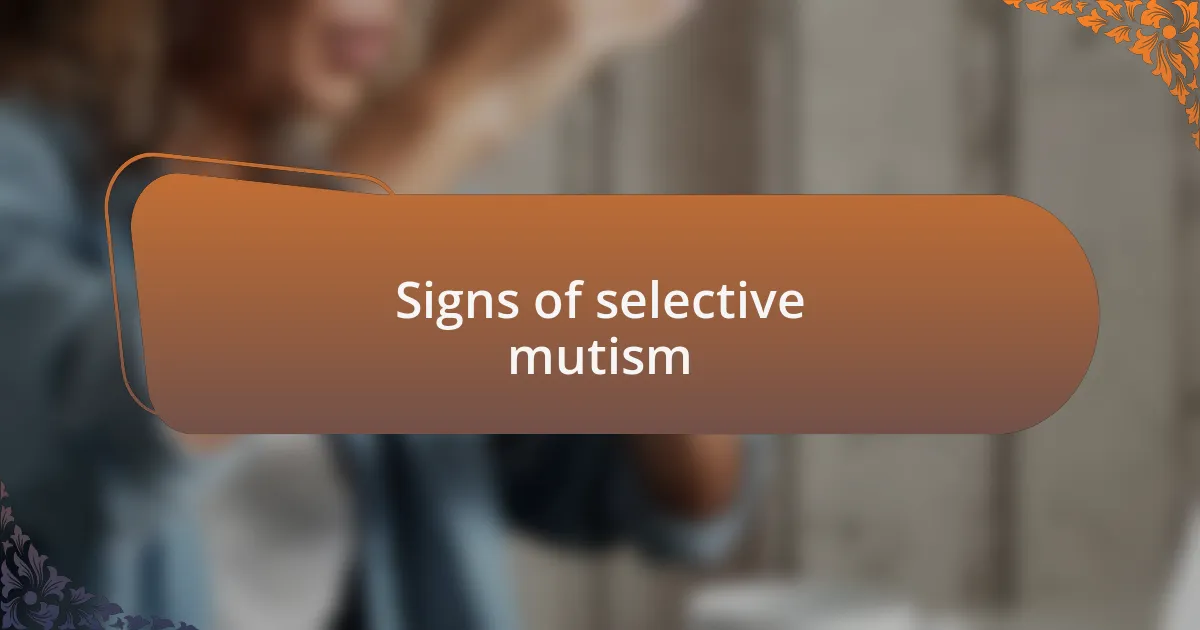
Signs of selective mutism
When observing signs of selective mutism, you might notice that a child communicates effortlessly at home but suddenly becomes mute in social settings. I remember a friend’s daughter who would chatter away with family but would freeze in her preschool, almost as if a switch flipped. It’s striking how environments can dramatically alter a child’s behavior—have you ever seen someone transform based on who they’re with?
Another red flag is physical symptoms like stomachaches or headaches that arise before social interactions. I recall feeling a tightening in my chest before speaking up in a group, a clear manifestation of anxiety. These reactions can signal that the child is grappling with more than just shyness. Isn’t it fascinating how our bodies respond to emotional stress in such tangible ways?
Additionally, a reluctance to participate in activities that involve interaction, like group games or class discussions, is a common sign. I once watched a boy sit on the sidelines during recess, his longing to join visible but stifled by his fears. These moments highlight the internal struggle a child faces—do you think it’s possible that what seems like simple shyness can be a deeper struggle?
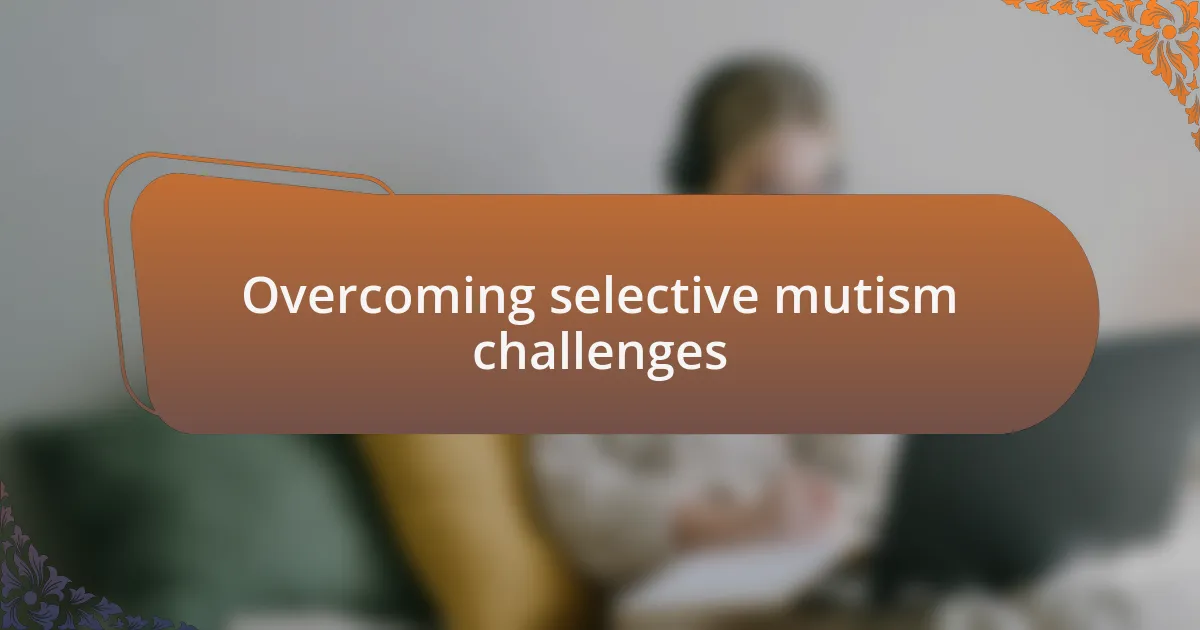
Overcoming selective mutism challenges
One of the most significant challenges in overcoming selective mutism is the fear that clings tightly to those grappling with it. I remember participating in a group therapy session where we ventured into small talk—a seemingly innocuous task that felt monumental to many. Each word felt like a mountain to climb, and it struck me how pushing through that discomfort gradually transformed our perspectives on communication. Have you ever faced a fear that seemed insurmountable until you took that first step?
Another hurdle is the misconception that silence equates to indifference. I had a moment with a teacher who mistook my quietness for a lack of engagement. When I finally mustered the courage to share my thoughts, it became clear that many people misunderstood silence as apathy. Isn’t it interesting how perceptions can skew our understanding of someone’s feelings and experiences?
Building supportive environments is essential, too. I once attended a supportive workshop where participants celebrated each small victory, like saying “hello” or asking a question. It was refreshing to witness how nurturing environments encourage us to break our silence. What if we could all create spaces where every voice, no matter how quiet, is valued?
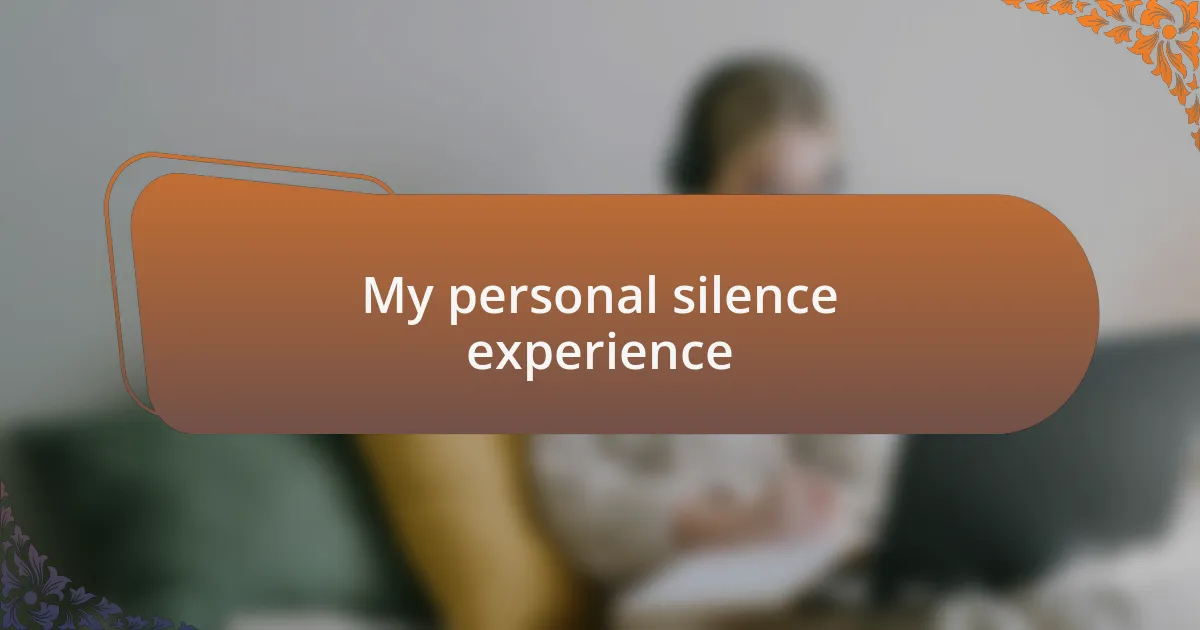
My personal silence experience
There were moments in my life when my silence felt like a protective barrier, one I didn’t know how to break. I recall sitting in a crowded room, my heart racing while I remained mute, longing to voice my thoughts yet feeling trapped by a heavy weight of anxiety. That blend of fear and desire created an internal struggle that was both exhausting and isolating.
During a particularly quiet lunch at school, a friend nudged me and asked why I hardly spoke. The question surprised me; I wanted to share stories and laughter, yet words rarely emerged. In that instant, I realized how my silence was not just mine to carry but also a veil over my friends’ understanding of who I was. Isn’t it curious how our internal experiences often remain unknown to those around us?
Reflecting on those moments now, I understand that my silence taught me about empathy and patience. I remember a day when a kind classmate quietly offered me their notes, sensing I might struggle to participate in discussions. That small gesture reminded me: sometimes, silence speaks volumes, revealing complexities that words simply cannot encapsulate. Have you ever experienced a moment when silence became a bridge, connecting you in unexpected ways?
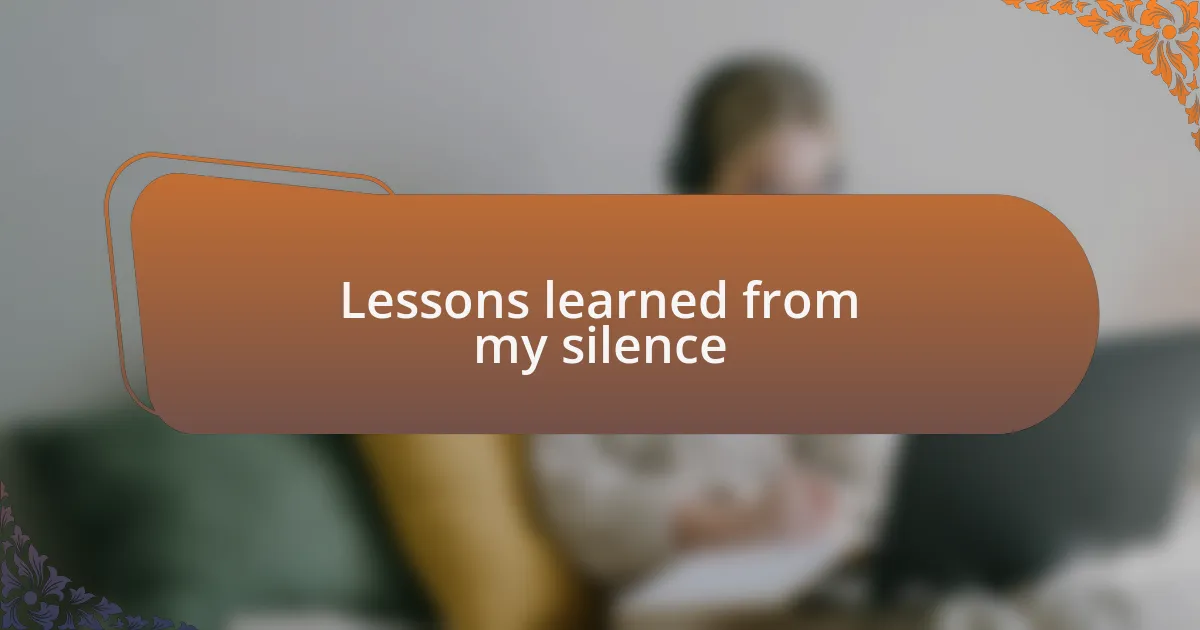
Lessons learned from my silence
Sometimes, I’ve found that my silence serves as a powerful form of communication. I recall a time when I attended a family gathering, surrounded by laughter and chatter. Instead of feeling left out, my quiet presence allowed me to observe and absorb emotions, deepening my understanding of my loved ones—a lesson that sometimes, being still can be just as impactful as speaking.
There were days when my silence stood in stark contrast to the noise around me, prompting reflections on the nature of connection. I remember sitting in the park, listening to the conversations of those nearby. It hit me that silence fosters deeper insights; I learned to appreciate the nuances of body language and facial expressions. Have you recognized how much can be revealed in silence, even in the absence of words?
I have also learned the importance of self-advocacy through my silent moments. There was an instance where I wanted to participate in a discussion but felt paralyzed by fear. Eventually, I mustered the courage to write my thoughts down and handed them to the facilitator. That day, I discovered a new way to express myself—one that embraced my silence while allowing my voice to be heard in another form. Isn’t it intriguing how silence can inspire creativity in expressing our true selves?
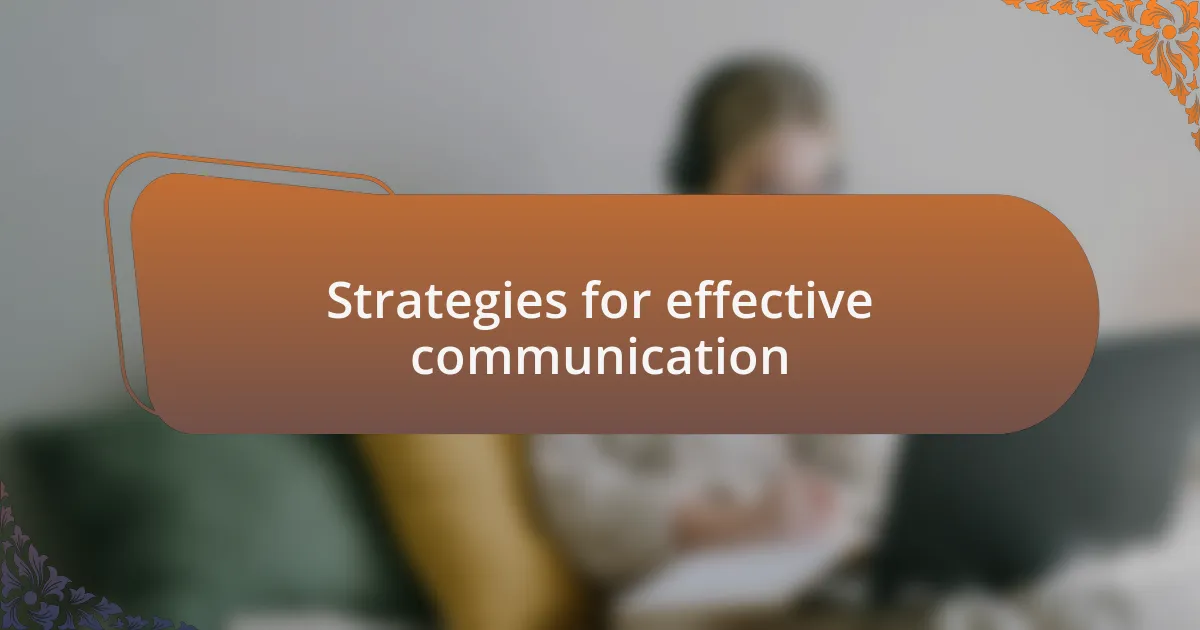
Strategies for effective communication
When navigating the complexities of communication, I’ve learned the value of alternative methods. For example, when verbal expression felt daunting, I leveraged technology to share my thoughts. Sending a thoughtful text instead of speaking allowed me to convey my feelings without the pressure of face-to-face interaction. Aren’t we fortunate to live in an age where expressing ourselves can take many forms?
I also discovered that visual cues can be incredibly effective. During a group project, I chose to illustrate my ideas through drawings rather than verbal explanations. This approach not only eased my anxiety but also helped others engage with my perspective more organically. Have you ever considered how visuals can bridge gaps in communication, especially when words feel heavy?
Moreover, creating a safe space to exchange thoughts has proven essential. I remember a friend who initiated a roundtable discussion where silence was welcomed, giving everyone a chance to reflect before speaking. This experience taught me that when conversations are rooted in patience and understanding, silence transforms from a barrier into a bridge, fostering deeper connections. Isn’t it empowering to realize that effective communication often thrives in the quiet moments?